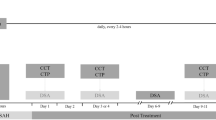Summary
Although the pathophysiology of chronic cerebral vasospasm following subarachnoid haemorrhage (SAH) is still unclear, it is certain that the amount of subarachnoid blood is predictive of the severity of cerebral vasospasm. Accordingly, massive subarachnoid haemorrhage (>0.5 ml) was induced in adult rats via direct injection into the cisterna magna. Compared to other previously published models of experimental SAH in rats a much larger amount of blood was injected.
The basilar artery was exposed 72 hours post subarachnoid haemorrhage and photographed under controlled conditions. The diameter of the artery was assessed by an image analyzer. A 50% reduction in diameter was found in 25 rats subjected to SAH as compared to 9 control rats and 4 rats with intracisternal saline injection.
We conclude that when massive subarachnoid haemorrhage is induced, and direct measurements of the basilar artery are made, the rat can be used as a reliable model for investigation of SAH induced arterial vasospasm.
Similar content being viewed by others
References
Barry KJ, Gogjian MA, Stein BM (1979) Small animal model for investigation of subarachnoid haemorrhage and cerebral vasospasm. Stroke 10(5): 538–541
Brawley BW, Strandness DE Jr, Kelly WA (1968) The biphasic response of cerebral vasospasm in experimental subarachnoid hemorrhage. J Neurosurg 28: 1–8
Echlin FA (1969) Vasospasm acute and recurrent due to experimental subarachnoid hemorrhage. Excerpta Med Int Cong Series 193: 49–50
Fisher CM, Kistler JP, Davis JM (1980) Relation of cerebral vasospasm to subarachnoid hemorrhage visualized by computerized tomographic scanning. Neurosurgery 6: 1–9
Hashi K, Meyer JS, Shinmaru S, Welch KMA, Teraura T (1972) Hemodynamic and metabolic changes in experimental subarachnoid hemorrhage in monkeys. Europ Neurol 8: 32–37
Kagstrom E, Nilson PE, Svenngrad NA (1969) Clinical and experimental spasm of the cerebral vessels. Excerpta Med Int Cong Series 193: 60
Kamiya K, Kuyama H, Symon L (1983) An experimental study of the acute stage of subarachnoid hemorrhage. J Neurosurg 59: 917–924
Kuwayama A, Zervas NT, Belson R, Shintani A, Pickren K (1972) A model for experimental arterial spasm. Stroke 3: 49–56
Lacy PS (1988) A non-traumatic approach to ventral subarachnoid space near circle of willis. J Neurosci Methods 25(3): 239–242
Petruk KC, West GR, Marriot MR, McIntyre JW, Overton TR, Weir BK (1972) Cerebral blood flow following induced subarachnoid hemorrhage in the monkey. J Neurosurg 37: 316–324
Saito I, Sano K (1980) Vasospasm after aneurysmal rupture: incidence, onset, and course. In: Wilkins RH (ed) Cerebral arterial spasm. Williams & Wilkins, Baltimore, pp 294–301
Simeone FA, Trepper PJ, Brown DJ (1972) Cerebral blood flow evaluation of prolonged experimental vasospasm. J Neurosurg 37: 302–311
Smith RR, Yoshioka J (1985) Intracranial arterial spasm. In: Wilkins RH, Rengachary SS (eds) Neurosurgery, Vol 2, McGraw-Hill, Inc., pp 1355–1362
Solomon RA, Lobo Antunes J, Chen RYZ, Bland L, Chien S (1985) Decrease in cerebral blood flow in rats after experimental subarachnoid hemorrhage: a new animal model. Stroke 16(1): 58–64
Suzuki J, Komatsu S, Sato T (1980) Correlation between CT findings and subsequent development of cerebral infarction due to vasospasm in subarachnoid haemorrhage. Acta Neurochir (Wien) 55: 63–70
Swift DM, Solomon RA (1988) Subarachnoid hemorrhage fails to produce vasculopathy or chronic blood flow changes in rats. Stroke 19(7): 878–882
Takahashi S, Sonobe M, Nagamine Y (1981) Early operations for ruptured intracranial aneurysms. Comparative study with computed tomography. Acta Neurochir (Wien) 57: 23–31
Tsukahara T, Arista A, Kassel NF (1989) The distribution of intravenous nicardipine in rat brain after subarachnoid hemorrhage. Surg Neurol 32(3): 188–194
Umansky F, Kaspi T, Shalit MN (1983) Regional cerebral blood flow in the acute stage of experimentally induced subarachnoid hemorrhage. J Neurosurg 58: 210–216
Varsos VG, Liszczak TM, Han DH (1983) Delayed cerebral vasospasm is not reversible by aminophylline, nifedipine, or papaverine in a “two-haemorrhage” canine model. J Neurosurg 58: 11–17
Wilkins RH (1980) Attempted prevention or treatment of intracranial arterial spasm: a survey. Neurosurgery 6: 198–210
Author information
Authors and Affiliations
Rights and permissions
About this article
Cite this article
Ram, Z., Sahar, A. & Hadani, M. Vasospasm due to massive subarachnoid haemorrhage — a rat model. Acta neurochir 110, 181–184 (1991). https://doi.org/10.1007/BF01400688
Issue Date:
DOI: https://doi.org/10.1007/BF01400688




